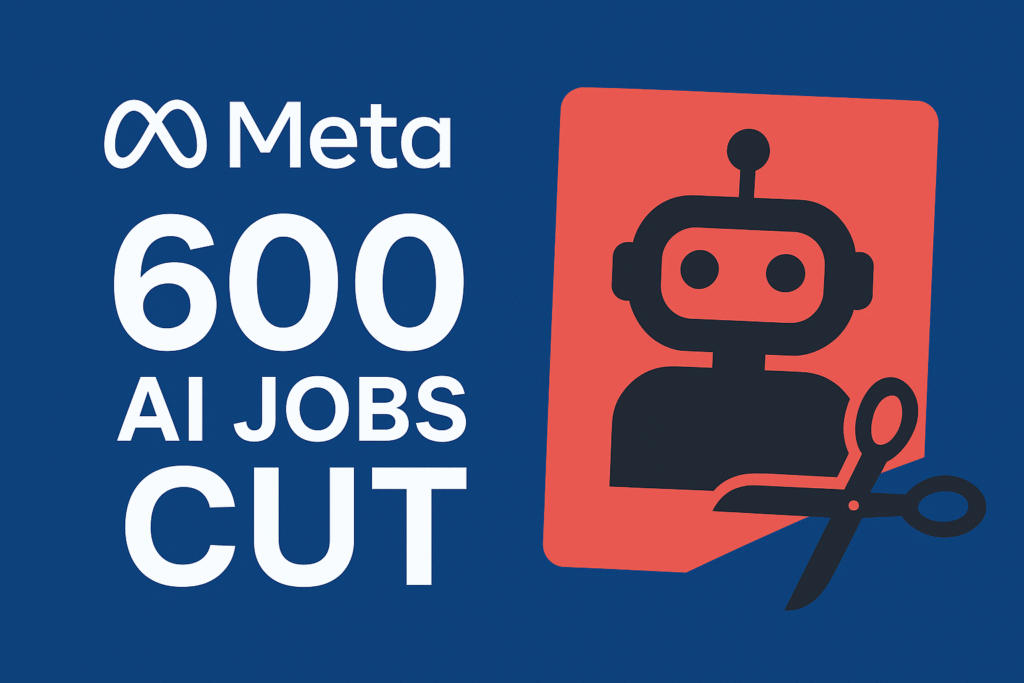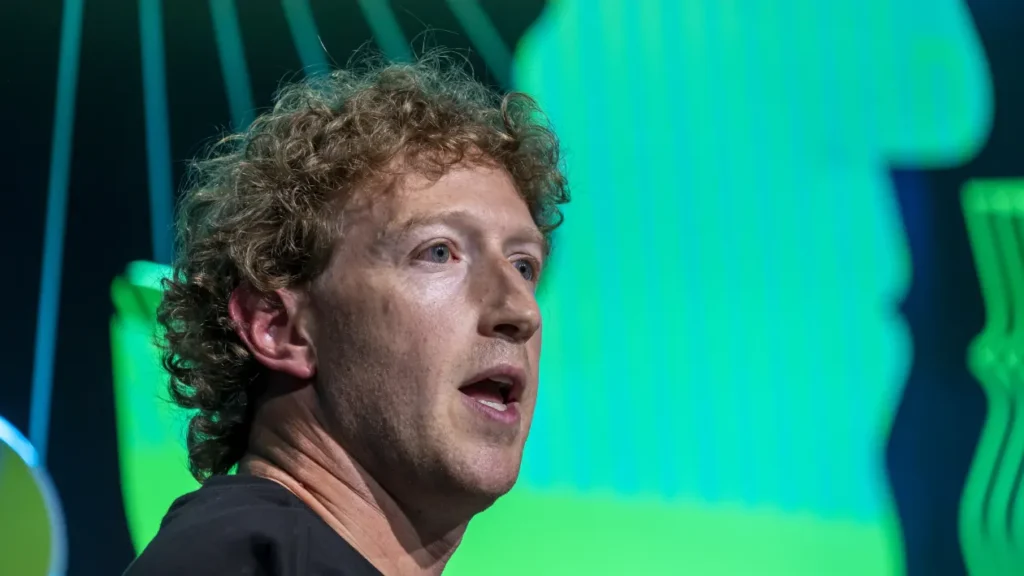Understanding Meta’s Latest AI Move
Meta AI layoffs: In a surprising but strategic decision, Meta has laid off nearly 600 employees from its AI division, sending a clear signal that the company is tightening focus on what truly matters — speed, efficiency, and next-gen superintelligence research. This move isn’t just another round of tech layoffs. It’s a calculated restructuring that could redefine how Meta approaches artificial intelligence, computing infrastructure, and its long-term superintelligence goals.
Let’s break down what really happened — and why it matters.

The Big Cut: 600 Roles Gone, Focus Narrowed
According to internal reports and coverage from CNBC, SFGate, and Axios, Meta has slashed jobs across three major units:
- AI product development,
- AI infrastructure, and
- Meta’s legacy FAIR research group (Fundamental AI Research).
The only team spared from this wave is Meta’s TBD Lab, a newly formed group working on superintelligence — the kind of AI that could surpass human cognitive abilities. This shows where Mark Zuckerberg’s priorities lie. Meta wants to build fewer things, but do them better.
Why Meta Is Trimming Its AI Workforce
Layoffs in the AI world sound strange, especially when every tech company is doubling down on artificial intelligence. But for Meta, it’s about speed and focus.
Chief AI Officer Alexandr Wang shared that smaller, tighter teams make faster decisions, reduce bureaucracy, and increase the impact of individual engineers. It’s part of Meta’s new efficiency drive, one that started after Zuckerberg’s 2023 “Year of Efficiency” announcement — a promise to remove bloat and make Meta operate like a nimble startup again. This time, the same idea is being applied to its AI division.
Similar strategic shifts have been covered in our piece on Google’s AI Hub in India, where Google streamlined its AI operations for greater innovation speed.

Superintelligence: The Endgame of Meta’s AI Ambition
Behind this restructuring sits one massive goal — the creation of superintelligent AI systems.
Meta’s TBD Lab (short for “To Be Determined”) is now the centerpiece of this mission. It operates almost like an internal startup within Meta — small team, huge mission, enormous computing budget.
This lab has access to Meta’s $116 billion AI hardware investments, including data centers, GPUs, and specialized chips. While other divisions faced cuts, TBD Lab remains untouched, signaling that Meta sees superintelligence as the next major frontier after social media and the metaverse.
The Shift from Research to Results
For years, Meta poured billions into FAIR, its open research initiative. It was respected among scientists, but it didn’t always align with Meta’s commercial goals.
Now, the company wants faster prototypes, not just published papers. This shift shows how Meta is evolving from being an academic AI powerhouse to becoming a product-driven AI company focused on real-world outcomes — like smarter assistants, better recommendation systems, and advanced AI agents that could power the metaverse.
AI Layoffs Amid Investment? The Irony Explained
It might sound contradictory — firing AI researchers while investing billions in AI hardware. But this isn’t about pulling back; it’s about restructuring how the money is used.
Meta is spending heavily on computing infrastructure, data pipelines, and custom AI chips, areas that require enormous resources. The layoffs reflect a shift from manpower to machine power. Meta wants to allocate funds to AI infrastructure rather than a sprawling workforce. In other words, fewer researchers, more compute.
For a broader view of how tech giants balance AI investment with layoffs, check out post on Google’s AI Infrastructure Push.
What This Means for Meta Employees
For the roughly 600 people affected, Meta has promised internal transfers where possible and generous severance packages. However, many in the industry see this as a wake-up call — even top-tier AI talent isn’t immune when corporate priorities change.
Some former Meta engineers have already begun joining OpenAI, Anthropic, and Google DeepMind, where the race for AI leadership is still accelerating.

David Paul Morris | Bloomberg | Getty Images
The Bigger Trend: Tech Giants Go Lean
Meta isn’t alone in this new AI strategy. Tech companies across the world are reorganizing AI teams to focus on applied research and product-ready models instead of theoretical experiments.
Microsoft restructured its AI research arm earlier this year. Google merged its DeepMind and Brain teams in 2024. Now Meta is following the same playbook — streamline, consolidate, and scale efficiently. It’s a new era of AI talent consolidation and cost discipline across Silicon Valley.
The Real Message Behind the Cuts
Beneath the headlines, Meta’s layoffs aren’t a retreat from AI — they’re a recalibration. Zuckerberg wants to turn Meta into a super-efficient AI factory, where innovation happens fast and data flows even faster.
The AI layoffs, the TBD Lab restructuring, and the shift toward superintelligence all point to one thing: Meta is moving from research-heavy exploration to execution and results. This is Meta’s next big evolution after the metaverse — and possibly, its most ambitious yet.
Tech’s New Trend: Lean AI Labs
Meta’s move fits a larger trend across Silicon Valley. After years of over-hiring, companies are now reorganizing AI divisions to focus on high-impact research and commercial products.
- Google merged DeepMind and Brain into one unit in 2024.
- Microsoft restructured its AI Research division earlier this year.
- Amazon is centralizing its AI efforts around AWS and Alexa innovation.
Meta’s strategy is clear — cut excess, keep vision. The result is a leaner, performance-driven culture that rewards output over headcount.
Meta’s Long Game: Building a Superintelligent Future
All signs point to one long-term goal — AI superintelligence. Meta’s internal roadmap, paired with massive infrastructure spending, shows a vision where its platforms are powered by adaptive, reasoning AI systems. Imagine smarter assistants in Messenger, predictive systems in Instagram, and automated moderation tools that learn in real-time. This is where Meta wants to lead — AI that feels human, learns fast, and scales globally. But whether this leaner approach will get them there remains to be seen.
Conclusion: Leaner, Faster, Sharper Meta
Meta’s AI reorganization is more than just a cost-cutting story. It’s about reshaping its identity in the AI world. By reducing team sizes, consolidating efforts, and betting big on superintelligence, Meta is positioning itself for the next wave of computing evolution.
The coming years will reveal whether this new, leaner Meta can truly compete with AI giants like OpenAI and Google DeepMind — or whether it risks trimming too much, too fast. Either way, one thing’s clear — the AI race just entered a new phase, and Meta is sprinting toward the future with fewer runners but a much faster stride.

Samsung Galaxy Watch Ultra (2025)
Take on every adventure with Samsung’s toughest smartwatch yet. Featuring a premium titanium build, stunning AMOLED display, advanced health tracking (ECG, SpO₂, sleep insights & more), and a battery that lasts up to 3 days—this is more than a watch, it’s your ultimate wrist companion. READ MORE
